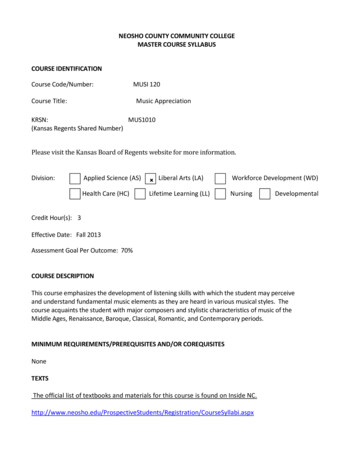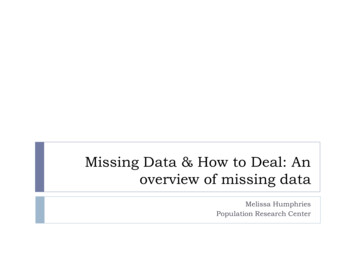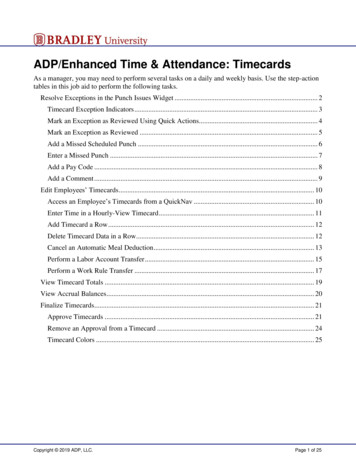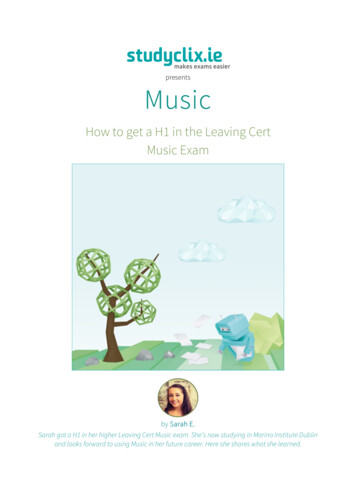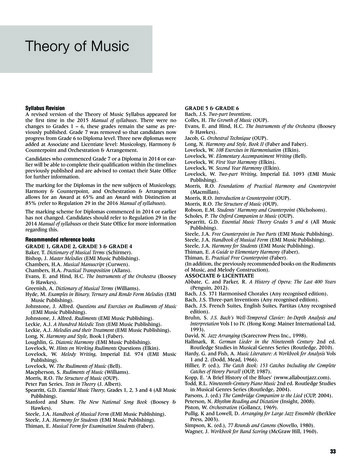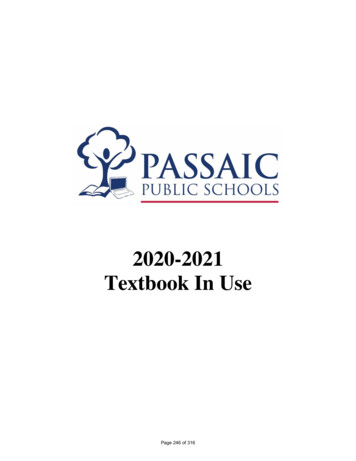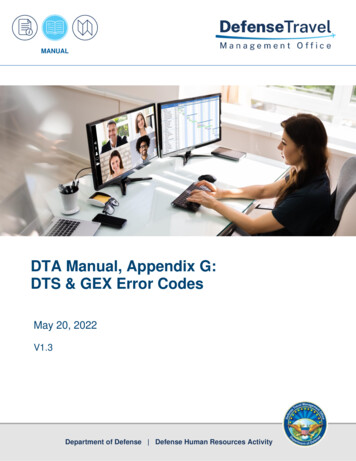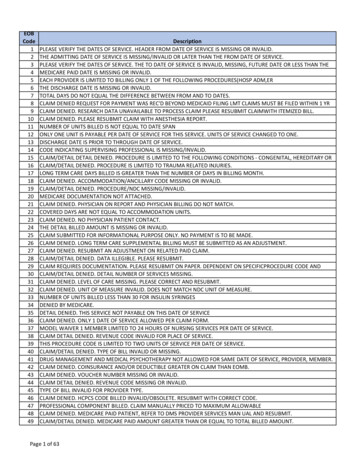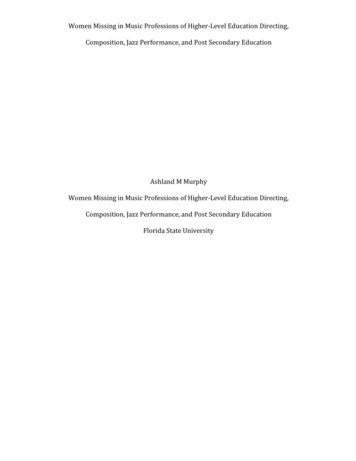
Transcription
Women Missing in Music Professions of Higher-Level Education Directing,Composition, Jazz Performance, and Post Secondary EducationAshland M MurphyWomen Missing in Music Professions of Higher-Level Education Directing,Composition, Jazz Performance, and Post Secondary EducationFlorida State University
Women Missing in Music Professions of Higher-Level Education Directing,2Composition, Jazz Performance, and Post Secondary EducationAbstractWomen have been involved in music throughout their experience in secondary andpostsecondary education for centuries. Females are experienced in the field ofmusic, but many practices today are still masculine and dominated by males invarious music professions. In order to combat this, music educators must work torecruit more females to the music and music education field while students areyoung. Women are notably missing in higher-level education directing, composition,jazz performance, and post secondary education. With advocacy and a strongrepresentation for females in collegiate positions, more females may be recruited tojobs in higher education. Parents and teachers are responsible for creating a senseof confidence in students. With this confidence in music, students can feelcomfortable choosing music as a degree program in college and as a career.Teachers must be persistent and encourage students that hard work will result insuccess in music.Gender tendencies in musical subjectsLucy Green (2002) researched school- aged children and surveyed themabout their experience in music classes. She established the “affirmation offemininity,” the theory that girls are seen as strong in voice, string instruments,keyboard, and generally classical instruments. Girls are more likely to conform tovalues and expectations of the school and teacher in an educational setting. Femalesstrongly associate music as a means of expression. However, girls tended to beconventional and conservative in their music composition. Compositions heard are
Women Missing in Music Professions of Higher-Level Education Directing,3Composition, Jazz Performance, and Post Secondary Educationmost likely composed by men; therefore, composition could be seen as moremasculine in nature. Schools may offer a wide variety of choices for music classes,but historical connotations may cause women to conform to female roles (Green,2002).Lucy Green’s work is relevant because of the perception of females in a musicclassroom. Based on the results above, even young students think of females asbeing drawn to a specific type of instrument or music. While schools are trying tooffer a variety of classes that will hopefully push stereotypes away from the musicclassroom, often times these classes are taught in the same manner as otherperforming arts classes and therefore encourage the same stereotypes.The role of women in music can also be sexualized, especially in jazz. Thelack of female participation in instrumental jazz music stems from decisions made atan early age. Many females choose instruments that are not primary jazzinstruments. In a study by Kathleen M. McKeage, she found that 28% of women and72% of men reported a primary instrument commonly found in jazz ensembles(McKeage, 2004). McKeage also found that 52% of women and 80% of men reportedthat they participated in jazz in high school. Only 14% of women and 50% of menparticipated in jazz in college (McKeage, 2004). The attrition rate for females in jazzperformance is much greater than that of males that accounts for the lack of femalesin the professional jazz community. In conclusion, there is a significant relationshipbetween gender and participation in jazz ensembles.
Women Missing in Music Professions of Higher-Level Education Directing,4Composition, Jazz Performance, and Post Secondary EducationStudents and teachers should be informed of the role of women andstereotypes of women in music. In the future this may create a better relationshipbetween learning, teaching and doing. Music education may be understood in abroader realm in which males see music from the female perspective, as womanhave for much time (Lamb, 1994).Recruitment and Influence for Music Majors in Postsecondary EducationMusic educators have been leaving the profession rapidly, necessitatingadministrators to hire unqualified individuals for the music classroom. While the NoChild Left Behind (NCLB) legislation was widely controversial, it did increaserequirements for public school teachers. This in turn increased the need for highlyqualified teachers as defined by NCLB. It is important to study why students choosemusic education and directing as a career path so that more highly qualifiedteachers can be recruited. Students surveyed by Jeff Bright (2006) were consideredto be outstanding band students with the intention to become music educationmajors (Bright, 2006).In this same study, students cited parent and teacher influence as animportant factor in choosing to become a music education major. This finding hasbeen verified in other studies as well. Another influence was students having theopportunity to teach and lead in the music classroom. Not only is the number offemales who enter the music education profession lower but also women have ahigher percentage of dropout rates within the first few years of teaching. Currentteachers should work to specifically guide and encourage females to enter the music
Women Missing in Music Professions of Higher-Level Education Directing,5Composition, Jazz Performance, and Post Secondary Educationeducation profession (Bright, 2006). Students who were more confident in theirtalent were more likely to choose music as a career. Because most students decidetheir major in high school, high school teachers and private teachers wereconsidered some of the most influential people in a student’s career choice(Gillespie and Hamman, 1999).Women in Collegiate Director PositionsCaucasian males dominate the realm of postsecondary music directors andprofessors. Sheldon and Hartley (2012) conducted a survey of instrumentaldirectors at the Midwest Clinic attempting to observe the gender and ethnicityamongst music directors. Only 7.56 percent of conductors were women. Womenwere most present in the junior high or middle school positions, but even so, thisstill only represents 5.8 percent of all primary conductors (Sheldon & Hartley,2012).Deborah Sheldon and Linda Hartley (2012) note that providing role modelsfor young musicians to become collegiate directors is critical to providing a varietyof future directors including women and various ethnicities. Half of undergraduateinstrumental music education students are females, but the rate drops considerablyfor graduate students. Only five percent of collegiate band directors are female. Theposition of a university band director may be considered a gendered role. Evensomething as simple and meaningful as conducting gestures may have a feminine ormasculine tendency. This trend continues when retiring band directors in college
Women Missing in Music Professions of Higher-Level Education Directing,6Composition, Jazz Performance, and Post Secondary Educationseek out directors who are like themselves, often male and often Caucasian (Sheldon& Hartley, 2012)Gender equity is a concern in society. Payne (1996) believes that society isde- sensitized to gender equity, including the financial unfairness that still exists inthe job market. Music is also stereotyped as feminine, yet women are not wellrepresented in higher education. Women in major American colleges who do holdpositions are represented at lower levels and lower salaries. Professionals arguethat women are not qualified for the high- level tenured tracks at universities;however, this is untrue. Women obtain approximately fifty percent of all masters’degrees. The majority of females working in colleges of music earned a doctoral ormaster’s degree. Females are most represented in colleges of music in the followingfields: keyboard, voice, theory and analysis, and music education. However, womenare missing almost entirely from the following fields: band, brass, composition,conducting, and orchestra (Payne, 1996).Influences of Self Esteem and Confidence in MusicBoth intrinsic and extrinsic factors contribute to student confidence in musicknowledge, music performance, and overall participation in music. High schoolcourse offerings in music continue to increase; however, participation is decreasing.Some dropout is due to curricular and extra- curricular pressure. Other factorsinclude parent pressure, poor student to teacher relations, loss of interest, andnegative self- image. Poor self- image is a concept that starts at a young age. Adultsmust combat these thoughts early in student development. Music can help or hurt
Women Missing in Music Professions of Higher-Level Education Directing,7Composition, Jazz Performance, and Post Secondary Educationthese thoughts. For example, students may think poorly of themselves if theyreceive a low score in a music assessment. Other factors such as grade level,socioeconomic status, and gender may influence self- image (Austin, 1990).Forty six percent of participants in Austin’s (1990) research did notparticipate in school music. Seventy percent of students did not participate inmusical activities outside of school. He also studied the effect of self- esteem onparticipation. Gender was the only significant main effect. The study also showedthat a higher degree of self- esteem resulted in higher participation in musicprograms. In the future teachers should particularly seek out students who needencouragement in the music class to keep them participating in music (Austin,1990).As explained earlier, teachers have a huge impact on the career path chosenby students. They also influence students’ self- perception. Little research has beencompleted on the influence of parents in regards to student personal identity.However, it has been proven that music students with parents who support andbelieve in their children are more likely to be successful and participate in music forlonger. Results from studies conducted by McClellan (2011) showed a moderatelyweak correlation between parental influences and self- concept as a music educator.A moderately positive result came from the parent’s belief that their son or daughtercan be a good music teacher, work with children, and complete the requirements forthe qualification of the position (McClellan, 2011).
Women Missing in Music Professions of Higher-Level Education Directing,8Composition, Jazz Performance, and Post Secondary EducationInternal reasons are accountable for most of a student’s belief that they willsucceed (or fail) in music. Positive self- concept and successful task performance arereliant on each other. The attribution theory states that an individual determinesachievement of a task with beliefs about the causes of success and failure. Eventssuch as ability and task difficulty are considered consistent and stable. Luck andefforts are unstable events. Females were found to attribute more internal, stablereasons for success in music (Asmus, 1986).Teachers are extremely influential in these results. Teachers who relateeffort to success are more likely to have students who adopt the same view. Asstudents increase in age, their attitudes change about attributes of success in music.Between the sixth and seventh grade students seem to change from effort relatedviews to ability related view (Asmus, 1986). It is important for teachers toencourage positive thinking and insist on a fierce effort in music at all times. Thiswill hopefully encourage students to continue their education in music andinfluence others that they can participate in music as well.My researchThere is a missing link between female students involved in school music andthe professional industry of music. In order to have more females in the areas ofhigher education directing, composition, jazz performance, and professionalconducting, there need to be more female role models in those areas. However, withfew females currently in those positions, young women must rise to the occasionand become involved in those professions on their own. This requires young women
Women Missing in Music Professions of Higher-Level Education Directing,9Composition, Jazz Performance, and Post Secondary Educationto be confident and comfortable not only in the field of music but also in theirpersonal lives.I created a survey that attempted to study the thoughts of students, gradesfive through twelve, in terms of musical potential and personal self-confidence. Iwas hoping to get at least 100 responses from students of all ages who had musicteachers that were male and female. I received 99 responses, but those answerscame mostly from students in grade five with female music teachers. The responsesmostly came from strings students in elementary schools in northern Virginia.Surveying proved to be a difficult but rewarding opportunity.The survey was anonymous and distributed electronically. There werecategorical questions with multiple-choice options as well as opinion questions,placed on a Likert scale from one to ten. Because the survey was for students,parental permission was given on a consent page prior to beginning the survey.Snapshots of the questions can be seen in the images below.
Women Missing in Music Professions of Higher-Level Education Directing,Composition, Jazz Performance, and Post Secondary Education10
Women Missing in Music Professions of Higher-Level Education Directing,Composition, Jazz Performance, and Post Secondary Education11
Women Missing in Music Professions of Higher-Level Education Directing,12Composition, Jazz Performance, and Post Secondary EducationIn order to use this data effectively, I used a Spearman correlations test. Thistested the significant relationship between the answers of any two questions. Nosignificant difference was found for the following sets of questions:“In general, I am a confident person. I have high self esteem” and “I feel confidentthat I am a good musician.”“My music instructor encourages me to be more involved in music” and “My musicinstructor inspires me to continue to be involved in music as an adult.”“My music instructor helps me learn” and “I feel confident that I am a goodmusician.”There was a small but significant difference between the answers to “I feel confidentthat I could be successful in a music career as an adult” and “In general, I am aconfident person. I have high self esteem,” producing a result of p 0.017. There wasalso a significant difference between “I like my music instructor” and “I feelconfident that I am a good musician,” producing a result of p 0.045.It is possible to conclude from these results that students have the samepersonal confidence level and confidence in their musical abilities. This wouldconfirm results found by Gillespie and Hamman in relation to confidence andperception of musical ability. When students like their music teachers, they tend tofeel more confident in their musical abilities. As proven by research by both Brightand Austin, the teacher has great influence over a student’s choice in musical career.
Women Missing in Music Professions of Higher-Level Education Directing,13Composition, Jazz Performance, and Post Secondary EducationMusic teachers should take care to value relationships with their female musicstudents.The teacher should encourage female students to pursue careers in highereducation directing, composition, jazz performance, and professional conducting. Ofcourse, the classroom is not just a place for females, so teachers should consider it agreat opportunity to educate all students on the influence of these professions aswell. There is often a stigmatism that these careers do not have any potential forsecure future. The music teacher needs to share the security and prospect of allmusic careers.Because this survey required parental consent on behalf of students underthe age of 18, it is possible that there is some biased in the results. Parents who areactively involved in the student’s music education may have been more likely torespond to the electronic survey and encourage their child to answer the questions.As mentioned by McClellan, parents who think positively of their child’sinvolvement in music are more likely to have students who think positively of theirmusic education as well.In future surveys, I hope to receive more responses from high schoolstudents. This could bring us closer to understanding the relationship betweenpersonal confidence and the missing numbers of females in careers of highereducation directing, composition, jazz performance, and professional conducting.Additionally, I would like to conduct further research to see if the late addition ofconducting, composition, and jazz to the music education curriculum prevents
Women Missing in Music Professions of Higher-Level Education Directing,14Composition, Jazz Performance, and Post Secondary Educationstudents from thinking of them as vital careers. Scales, listening skills, and notereading are vital to a beginning musician’s curriculum. However, in many methodbooks, conducting and composition are hardly present. They may indeed take upone or two pages in the method book. Some teachers could easily skip these pagesand concepts. Jazz is rarely found in the beginning method, and jazz method booksand music pieces are usually for more experience band students. I can say fromexperience, that jazz is missing almost entirely from the average strings and voicemusic class. With more study, we can possibly relate these missing musical topics inbeginning music curriculums to the missing females in their respective professions.ConclusionWomen are missing in music professions of higher-level education directing,composition, jazz performance, and post secondary education. Research has shownthat women are missing from the above-mentioned occupations for various reasons.Among all of the reasons it is most important that females find role models in thesefields. Female students must also find confidence in themselves and have thesupport of parents and teachers to encourage them. In time, with more focus ongetting female students to pursue these professions, they will no longer beconsidered male- dominated musical careers.
Women Missing in Music Professions of Higher-Level Education Directing,15Composition, Jazz Performance, and Post Secondary EducationReferencesAsmus, E. P. (1986). Student Beliefs about the Causes of Success and Failure inMusic: A Study of Achievement Motivation. Journal of Research in MusicEducation, 34(4), 262–278. http://doi.org/10.2307/3345260Austin, J. R. (1990). The Relationship of Music Self-Esteem to Degree of Participationin School and Out-of-School Music Activities Among Upper-ElementaryStudents. Contributions to Music Education, (17), 20–31.Bright, J. (2006). Factors Influencing Outstanding Band Students’ Choice of MusicEducation as a Career. Contributions to Music Education, 33(2), 73–88.Gillespie, R., & Hamann, D. L. (1999). Career Choice among String Music EducationStudents in American Colleges and Universities. Journal of Research in MusicEducation, 47(3), 266–278. http://doi.org/10.2307/3345784Green, L. (2002). I. Exposing the Gendered Discourse of Music Education. Feminism& Psychology, 12(2), 03Lamb, R. (1996). Discords: Feminist Pedagogy in Music Education. Theory IntoPractice, 35(2), 124–131.McClellan, E. R. (2011). Relationships among Parental Influences, SelectedDemographic Factors, Adolescent Self-Concept as a Future Music Educator,and the Decision to Major in Music Education. Bulletin of the Council forResearch in Music Education, (187), 49–64.Payne, B. (1996). The Gender Gap: Women on Music Faculties in American Colleges
Women Missing in Music Professions of Higher-Level Education Directing,Composition, Jazz Performance, and Post Secondary Educationand Universities 1993-1994. College Music Symposium, 36, 91–102.Sheldon, D. A., & Hartley, L. A. (2012). What Color Is Your Baton, Girl? Gender andEthnicity in Band Conducting. Bulletin of the Council for Research in MusicEducation, (192), .003916
recruit more females to the music and music education field while students are young. Women are notably missing in higher-level education directing, composition, jazz performance, and post secondary education. With advocacy and a strong representation for females in collegiate positions, more females may be recruited to jobs in higher education.
